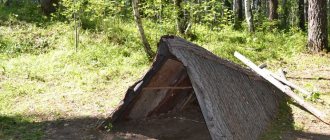Vladimir July 5, 2020 Category Life Safety
OBZH 2
Greetings, friends! Vladimir Raichev is with you, today I suggest you touch on the topic of life safety and consider a situation where it is necessary to build temporary housing.
Very unpleasant situations can happen to a person. He may get sick, break something, get lost in the forest, and so on. All of them require a person to have certain knowledge and skills in order to neutralize the consequences of these events.
But for certain situations, a person will need additional knowledge in order to survive not only himself, but also those people who got into trouble with him. Such knowledge includes: building a home without tools, obtaining food, sending distress signals, finding water, and so on. Even a superficial understanding of this will help a person survive in an emergency situation.
It should be remembered that when you find yourself in such a situation, first of all, do not panic. Panic is unlikely to help, but it will definitely take away the ability to think rationally. When the mind works, this is a good indicator, it will be easier to survive.
If a person gets lost in the forest, then he should not go wherever his eyes lead him. You should stop and send a distress signal, for example, using bright clothes on a tall tree. But what to do if there is no help for a very long time? That's right, we need to wait for her further. But how can we wait for help? You can do it outdoors, but it’s still more comfortable indoors. Let it be a hut, but even there it will be more pleasant to be than in the open air. At the same time, you can make a fire.
I recently saw on the Galileo program how houses are built. In Pushnov’s story, a rescuer, a tourist and a physicist find themselves in extreme conditions and their task is to complete a certain task. I won’t go too deep, see for yourself:
How to build a hut?
There are several ways to build a hut that provides at least minimal protection from wind and rain. It is unknown how stuck a person is in this situation, so it is better to build a home that has all the protective properties. It will take longer and be more difficult, but after constructing such a shelter, the lost person will be able to rest well, gain strength and think about further actions.
For such a home you will need:
- 2 poles 2.5 meters long;
- 4 poles 2 meters long;
- 3 poles 2.5 meters long.
They must have a girth of at least 10 cm.
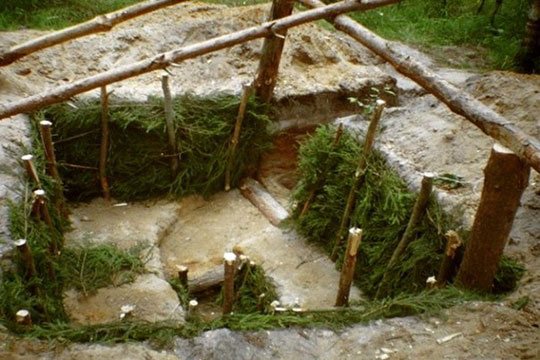
Life Safety Project “Temporary Housing”
Temporary housing
Objective of the project:
— formation of ideas about the main types and rules for the construction of temporary housing and shelters;
— training of people whose work requires skills in making temporary shelters;
— training students in life safety lessons, using the example of making a model of a gable hut.
Project objectives:
— learn to determine the rules for choosing sites for the construction of temporary housing and shelter;
— get acquainted with the main types of summer and winter temporary shelters and shelters;
— learn to navigate the variety of forms of temporary housing and shelters;
- develop skills in building summer and winter temporary shelters and shelters;
- make a model of one of the temporary shelters in order to use it for conducting life safety lessons.
P L A N:
- Introduction.
- Classification of shelter types.
3. Basic conditions for building a temporary shelter:
A) Choosing a place for temporary housing.
B) The influence of weather conditions.
B) Wind.
4. Types of shelters.
5. Making a model of a temporary dwelling using the example of a gable hut.
6. Conclusions.
- Introduction
From the primitive era until now, of all the sciences, sometimes the most important is the ability to survive in difficult conditions. A person’s salvation from adverse influences, primarily from cold and getting wet, is their home. On a hike - a tent. But what if this item is not there? How to find shelter in a forest or open field? How to make a winter shelter? There are answers to these questions.
What types of temporary shelters are there?
- Classification of shelter types.
Types of shelters are classified conditionally:
- According to the method of protecting animals from climatic influences, buildings are:
- closed (den, wigwam, tent, igloo, dugout, hut);
- open (canopies, hammocks in trees, decks in swamps).
- By capacity:
- individual;
- group.
- By purpose:
- winter shelter saves a person from freezing;
- summer protects from rain, wind, sun, mosquitoes, snakes.
- Based on source materials, types of shelters are more widely represented:
- fabric (canopy, tent, bivouac bag) - if there is covering material;
- frame-fabric (plagues, wigwams) - you need a frame of poles, metal tubes, skis, covered with canvas;
- frame-deciduous (canopy, hut, hut) - the fabric is replaced by spruce branches, branches with foliage, turf, tree bark;
- earthen (niche, hole, cave, dugout) - dig in the ground;
- snowy (they dig holes in snowdrifts, a hole, a trench, a cave, a man-made snow-covered den under a fallen tree - a winter shelter in the forest);
- reed huts made from bundles of reeds;
- adobe (huts made of adobe bricks, or fencing coated with clay, woven from poles and branches).
- By origin:
- natural (caves, gorges);
- man-made.
We find ourselves in an extreme situation, when normal existence in autonomous conditions requires housing, the construction of which is the most important problem for an unprepared person. What can be done?
In order to understand the essence, let's try to answer a few questions:
- Basic conditions for building a temporary shelter:
A) Choosing a place for temporary housing
What requirements must be observed when choosing a place for shelter?
The place should be dry and located near a stream or other water source so that there is always a supply of water nearby. It is important that there is fuel nearby (in winter the issue of firewood is very important). In summer, in an open place, so that the cool night breeze becomes a reliable protection against attacks by mosquitoes and midges.
When choosing the type of temporary shelter, use what is at hand. What kind of shelter to build must be decided depending on the specific situation and your skills.
What should a temporary shelter protect against?
From precipitation, scorching sun, strong wind, cold.
Therefore, it is better not to save time on its construction. The main thing is to immediately build a shelter for the night. More extensive construction can begin the next day.
What can be used to build a shelter?
Natural material, improvised means can serve as a raincoat, jacket, pieces of tarpaulin fabric.
How will weather conditions influence your choice?
B) Influence of weather conditions
Weather conditions are usually a determining factor in determining the location of your future shelter. For example, in cold climates in the lowlands it is usually a little colder at night, and it is also windy there. Being in a cold climate zone, you should try to build your shelter in the sun and use the maximum available amount of heat-insulating material. In desert conditions, a shelter should protect both from solar overheating during the day and from hypothermia at night.
How can wind help or hinder existence in the wild?
B) Wind
In a warm climate zone, you need to build a shelter in such a way as to take advantage of the refreshing breeze, but at the same time remember to protect the shelter from dust, dirt and debris that the wind may bring. In a cold climate zone, on the contrary, choose a place for shelter that is protected from the wind and the snow it brings.
Let's look at what types of temporary housing there are:
- Types of shelters
The type of suitable shelter is determined by the weather and climatic conditions in which the person is located, as well as the materials available for its construction.
If it is not possible to find any materials suitable for building a shelter, you can use natural shelters, such as an overhanging cliff or rock, or a depression in the ground. Below I have given a description of natural shelters that a person can use in an extreme situation:
Trunks of fallen trees or trees broken at some distance from the ground.
Natural depressions in the ground, crevices and holes. They provide excellent wind protection.
Trunks of fallen thick trees. You need to dig a hole on the side of the trunk protected from the wind and cover it on top with a roof of branches and spruce branches.
Small boulders and stones. To protect yourself from the wind, the gaps between the stones can be filled with clay, leaves mixed with dirt, or peat.
Cave. It can be an excellent hiding place. If its location is on the side of a hill, mountain or rock, you can improve its thermal insulation by building a wall in front of its entrance - a wind shield, for the construction of which you can use boulders and stones.
Of course, there are infinitely many types of shelters that can be built from scrap materials in the wilderness. You just need to stretch your imagination. But when building any of them, we must not forget the principles stated above.
- Conclusions:
I learned to determine the location for the construction of temporary housing.
I got acquainted with the main types of summer and winter temporary housing.
I learned to navigate the variety of forms of temporary housing.
Developed skills in building summer and winter temporary housing.
I made a model of one of the temporary housing, which will be used in life safety lessons.
In the summer, I will try to make these and other shelters myself in the wild.
Sources: StudFiles, studopedia, Yandex pictures, books for survival.
Roof installation
The roof is an important part of the building. To install it you need poles. They should cover with a margin the length from the central support to the side one. The protrusion must be at least 20 cm. For reliability, they are wound to each other at the corner (/\). The distance between them should be 50 cm.
That is, 5 such structures should go to the roof. Next, you need to cover the roof with the first layer of coating. You can use bark for this. It is necessary to rip off the bark from a thick tree in large pieces and place it on the roof. This design will protect the roof from leaks.
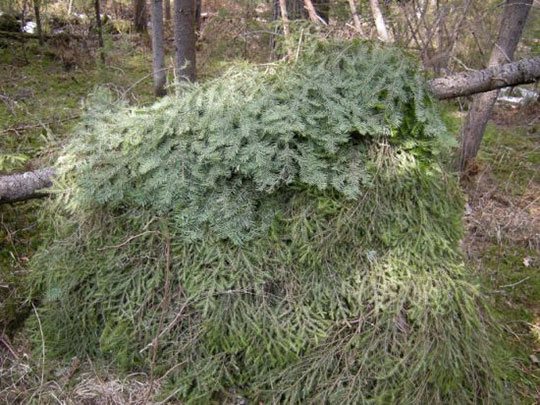
How to make a temporary shelter
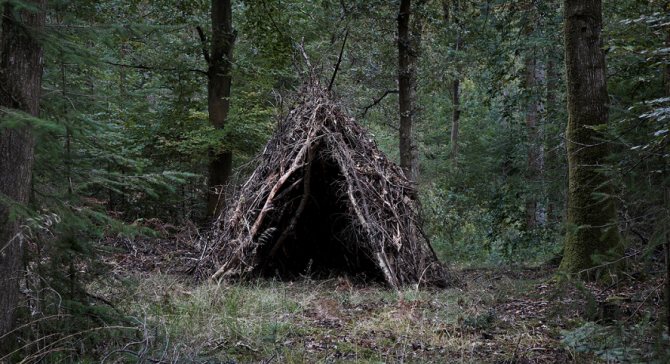
A prerequisite for human survival in extreme situations is the construction of a shelter. Shelter is necessary for protection from environmental influences. When building a temporary shelter, many factors must be taken into account: geographical location, possible dangers, availability of resources.
It is important to calculate the energy costs required for construction. Based on this, you need to properly plan your further actions.
Shelter functionality
The shelter you are going to build must meet the following parameters:
— Spaciousness. The shelter must accommodate a person and his belongings. The construction must be carried out taking into account the size of a person.
— Ergonomics. The shelter should be comfortable. The floor must be dry and level. The exit should be located so that they can get out at any time.
- Safety. The shelter must be safe and not pose a risk to life. Make sure that the walls and ceiling do not collapse.
- Protection from cold. The shelter should protect from the cold.
— Protection from moisture. The shelter must be dry. Getting wet will cause you to lose heat faster. It is preferable to choose hills and rocky areas for shelter.
— Wind protection. Strong winds lead to faster heat loss.
— Protection from animals. Choose a hiding position in places that are difficult to reach for predators and dangerous animals.
Temporary emergency shelter
The simplest shelters can be used not only for survival in extreme conditions, but also for shelter in emergency situations. For example, if there is a possibility of a man-made accident or enemy attack. Such shelters can serve as trenches, basements, and underground passages. Temporary shelter in such situations will protect against shock or heat waves and debris.
As a shelter, you can dig a hole 2-2.5 m deep and 1 m wide. The top of the hole can be covered with boards. To protect from moisture, throw 10-15 cm thick clay on top and cover it all with earth. The roof must be at least 1 m thick. For additional protection, sandbags can be placed on top. All this will help protect against radiation. In the event of a nuclear explosion, do not leave the shelter for 2 days. If you don’t have time to build a shelter, you can take shelter under a car or a fallen tree.
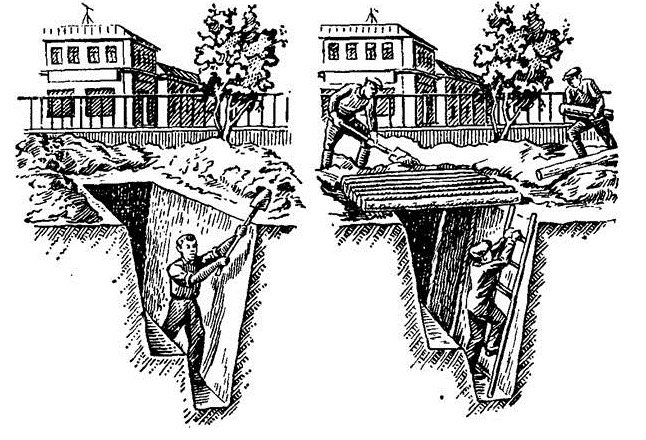
How to build a shelter with your own hands
When surviving in the wild, a shelter must protect from cold and heat, wind, water, and wild animals. The construction of a temporary shelter largely depends on the surrounding nature. In forest conditions, you can build a hut or a canopy. During snowy times, you can make a shelter out of snow.
Hut . To build a hut you will need poles, branches, spruce branches. First you need to clear an area sufficient for construction. The hut is quite comfortable and can protect from the cold. But for construction you may need an ax or other chopping tool.
Canopy . Building a canopy will not take much time and effort. It can be made from film, fabric, branches, straw.
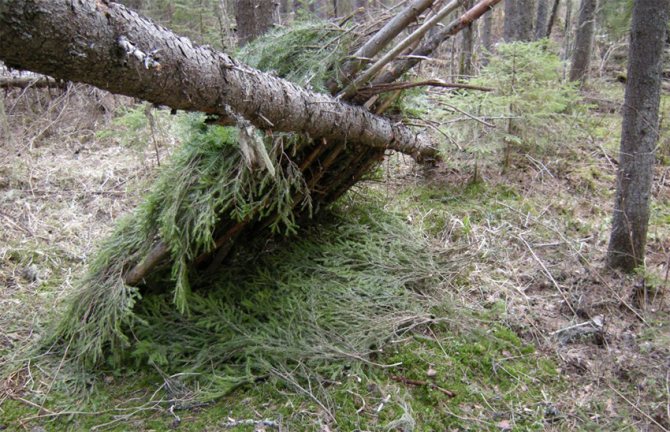
Shelter made of snow . You can easily dig a hole or hole in the snow. Such a shelter will reliably protect you from wind and cold.
It is much more difficult to build a shelter in the desert or steppe due to lack of materials.
How to Build a Temporary Shelter in the Desert
In the desert, due to weather conditions, shelter is essential. It should protect from the sun and from cold at night. Construction can be done either in the evening or in the morning when there is no heat and the chance of sunstroke is minimal.
If the area is covered with dunes, then if you have a piece of material you can easily build a shelter. At the top of the dune at the foot, secure the fabric, maybe with stones. Such a canopy will protect from the winds and provide shade. It is much more difficult to build a shelter on flat terrain. It is necessary to dig a hole 1-2 m deep. If possible, dig a hole next to a large stone. Pull the fabric over the top and secure it. If you have several awnings, then they can be pulled over each other with a distance of 15-20 cm, this will reduce the temperature under the canopy.
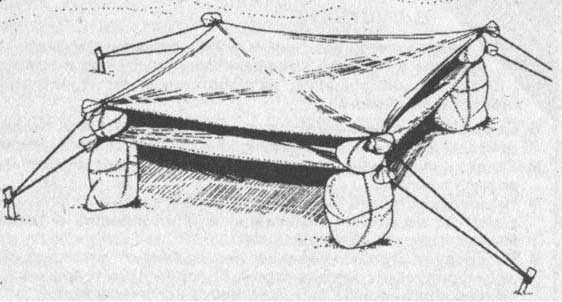
In case of a sandstorm, you can take shelter near a rock, tree, stone. It is advisable to be located on a hill. Be sure to cover your mouth and nose with some kind of cloth and cover yourself with a tent.
How to build a temporary shelter in the steppe or tundra
It is also not as easy to build a temporary shelter in the steppe or tundra as in the desert due to a lack of resources. The shelter can be made in a crevice in the rock. Before you settle in, make sure there are no snakes there. Grass and moss are placed at the bottom of the shelter, and on top you can stretch a piece of fabric and cover it with branches.
In the tundra, shelter should be located away from swamps. You should choose a sandy place or a crevice. Dwarf birch trees, moss, and shrubs are suitable as building materials. If there are no building materials available, then the shelter can be made in the ground. You can hide in a hole by covering yourself with earth. The soil retains heat well and protects from wind.
The construction of a temporary shelter is an aid to survival in extreme situations. Keep in mind that the shelter must be functional and protect from adverse conditions.
Walls
To keep the wind from blowing and keep it warm, any house needs walls. Here they need to be blinded. Most likely the person will stop near a pond. This is exactly what you need. There is dirt there, the main building material for such a dwelling.
First of all, you need to install a few additional poles to strengthen the walls. 2 - 3 per wall. Just don’t forget to leave room for entry (50 cm). After installing the poles, there is a tedious job of installing the walls. To do this, you will have to drag dirt and lay it from wall to wall in a layer of 10 cm, all the way to the roof.
Tools for building a winter shelter
Having decided on the location, you need to move on to construction. Let's consider each case separately.
woodland
To build a winter shelter in the forest, you need to decide on the type of shelter. The most suitable temporary shelter is a winter cave. An interesting paradox: to escape the snow and cold, you need to hide in the snow. If the location you choose is a small hill or flat area, then you need to dig yourself a hole.
Make sure that the cave or hole will not fall through and that the place is secure. Dig a hole of the required length to accommodate the required number of people. Make a small trench along the walls. With its help, cold air will fall down and accumulate there. Remove all snow outside. The exit can be covered with snow so that less wind gets inside. If you are digging a hole on a flat area, then build a roof from scrap materials.
If you have tarpaulin, use it. In its absence - with branches, leaves and everything else you find. Finding something in winter is much more difficult than in summer. Your shelter is ready. If you have a tent, you need to set it up on a more level surface and clear the area of branches and thickets.
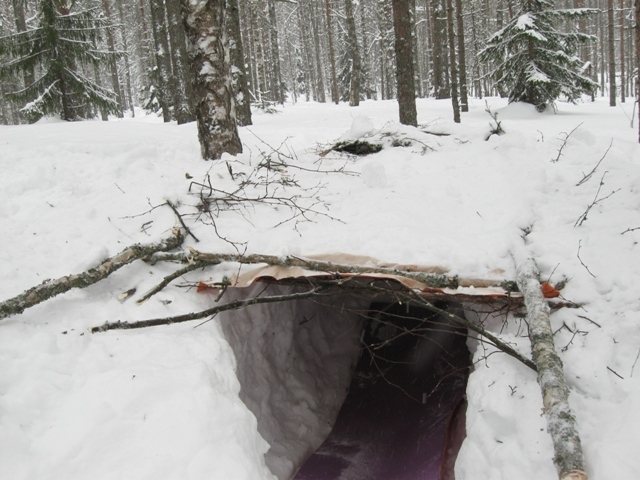
Shelter in the crevice
Mountain landscape
Having decided on a location (most likely a gorge or cave), dig the necessary hole, if necessary. If you find a real natural cave, you won't have to build it yourself. Rules for building a cave shelter like in a forest. It is necessary to additionally take into account that stones or snow may fall. You need to make sure you don't get hurt if this happens. If you have a tent, set it up on a flat surface, having first cleared the area of debris. Make sure that it will not fall from the wind, as the winds in the mountains are quite strong.
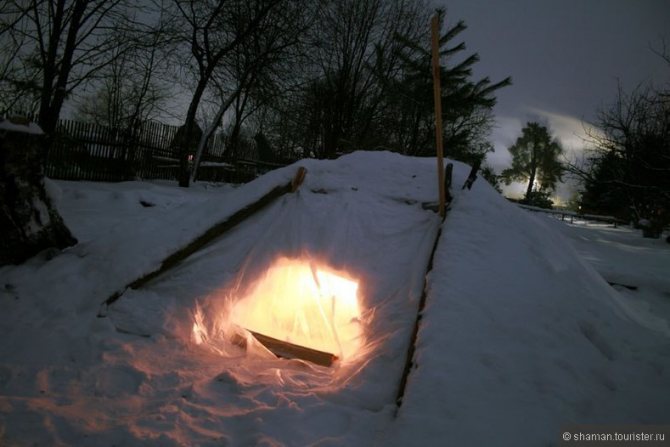
Snow Shelter
The next step is heating the winter shelter. The rules are the same here. Inside the shelter you need to make a fire from branches and sticks, but you need to be careful that it does not get too hot. Don’t rush to throw away wet branches; try cutting or breaking them in half. They may be dry inside and burn better.
You may have taken candles, they will also work. Any source of fire will warm the shelter if it is built airtight. The peculiarity of heating a snow shelter is that due to temperature changes, the snow begins to stick together inside and the walls become strong. During this process, cracks may form; they need to be covered with snow. The fire should not get too hot, otherwise you may be injured by the fire.
Ideally it should be small and create a lot of warm coals. Then the heat will remain for a long time. Find stones and put them in the fire. They will create additional heat like a stove. We should not forget that you need to dry things thoroughly so as not to sit in wet things. This will make it harder to stay warm.
Place to sleep
The hut is almost ready, all that remains is to make a place to sleep. This will require a dozen poles that are the same height as a person. Tie them together and place them against the wall. There is no need to worry about the lack of heat. The house is small, just a few square meters, and the stove does a great job of heating it.

This is the procedure for building a simple dwelling for a short time while rescuers are looking for a person. This house is designed for a month. But if you wish, you can live in it longer.
Well, the only thing missing in our home is Wi-Fi and satellite TV. But we will not carry them out. That’s all for today, subscribe to blog updates, share the link to this article with your friends, see you again, bye-bye.




